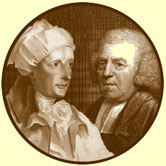| LACE HOME PAGE |
|
LOCAL LACE |
|
Lacemaking equipment: the flash-stool |
||
|
Adequate lighting was an important consideration in lace making. In warm weather the cottagers could work outside, or at an open door or window; but at night and during the dark days of winter the work was done by the light of candles. A tall flash-stool or candle-block concentrated the light from a single candle and focused it on the lace -pillow exactly where it was needed. The top or hole-board was pierced in the centre to take a nozzle. This was a wooden candle socket adjustable for the height of the candle. Around the nozzle were three, four or five holes to take the cups, i.e. wooden sockets which held the glass refracting flasks. The flask or flash, a glass globe with a long narrow neck, was filled with snow water or crushed ice - the purest water available. It was then corked and inserted into one of the cups. Here it acted as a condenser or lens concentrating and whitening the candle light. Other flasks were prepared and mounted according to how many lace makers were working together. By positioning the pillows around the flash-stool so that the candle light fell in a concentrated beam on each, three to five lace-makers could work comfortably by the light of a single candle. This is the origin of flash light. Most of the flasks were especially made for the purpose but round bottles, oil flasks and engravers' flasks were all used. Flash cushions, little open circles of plaited rush, were sometimes used as a rest for the flash . Hutches (baskets of plaited rush) packed with straw or rags, held and protected the flashes when not in use. Flash-stools are mentioned in the Overseers' Inventories at St Paul's Church, Bedford dated 1772. |
|
|
| Images & text © 2009 The Cowper & Newton Museum (unless stated otherwise) | website by Jeremy Cooper at oliomedia |


